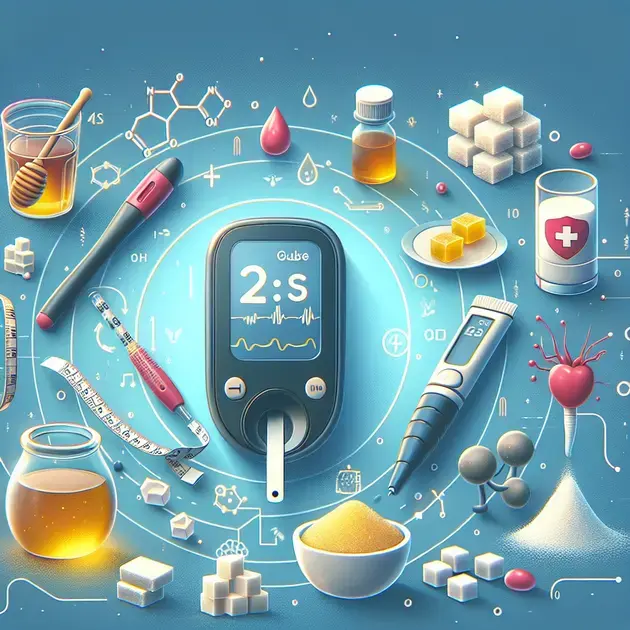
Managing Type 2 Diabetes: Understanding Sugar Levels
When it comes to managing type 2 diabetes, one of the key factors to consider is understanding sugar levels in the body. Monitoring blood sugar levels regularly can help individuals with type 2 diabetes make informed decisions about their diet, medication, and overall lifestyle.
With the advancement of technology, there are now various tools available to help individuals track their sugar levels more effectively. From continuous glucose monitors to smartphone apps, managing sugar levels has become more convenient and precise than ever before, empowering individuals to take control of their health and well-being.

Understanding Different Types of Sugar
Sugar comes in various forms and can have different effects on our health. It is important to understand the different types of sugar to make informed decisions about our diet. Some common types of sugar include:
1. Sucrose
Sucrose is the most common type of sugar and is found in sugarcane, sugar beets, and various fruits. It is often used as a sweetener in many processed foods and beverages. To identify sucrose in food labels, look for ingredients such as “sugar” or “sucrose.”
2. Fructose
Fructose is a natural sugar found in fruits, honey, and vegetables. It is sweeter than sucrose and glucose, making it a popular choice for sweetening products. High consumption of fructose, especially in the form of high-fructose corn syrup, has been linked to health issues such as obesity and insulin resistance.
3. Glucose
Glucose is a simple sugar that serves as the primary source of energy for our bodies. It is commonly found in carbohydrates and can raise blood sugar levels. Monitoring glucose intake is crucial for individuals with diabetes to control their blood sugar levels effectively.
4. Lactose
Lactose is a sugar naturally present in milk and dairy products. Some individuals may have lactose intolerance, which means their bodies cannot properly digest lactose. It is essential for people with this condition to be aware of their lactose intake and choose lactose-free alternatives.
5. High-Fructose Corn Syrup
High-fructose corn syrup is a sweetener made from corn starch and has become a prevalent ingredient in processed foods and beverages. It has been linked to various health issues, including obesity, heart disease, and liver damage. To reduce consumption, check food labels and opt for products with lower or no high-fructose corn syrup content.
The Importance of Regular Blood Sugar Monitoring
Monitoring blood sugar levels is crucial for individuals with diabetes to manage their condition effectively and prevent complications. Regular monitoring can help individuals:
1. Understand Their Trends
By consistently monitoring blood sugar levels, individuals can identify patterns and trends in their readings. This information can help healthcare providers adjust treatment plans accordingly and improve overall diabetes management.
2. Prevent Hypoglycemia and Hyperglycemia
Monitoring blood sugar levels can help individuals prevent episodes of hypoglycemia (low blood sugar) and hyperglycemia (high blood sugar). Maintaining blood sugar within a target range is essential for reducing the risk of severe complications.
3. Track the Effectiveness of Medications
Regular blood sugar monitoring allows individuals to track how well their medications are working. By observing changes in blood sugar levels in response to treatment, individuals and healthcare providers can make informed decisions about medication adjustments.
4. Improve Overall Health
Consistent monitoring of blood sugar levels promotes overall health and well-being. By keeping blood sugar levels in check, individuals can reduce the risk of long-term complications associated with diabetes, such as heart disease, kidney problems, and nerve damage.
5. Empower Individuals with Technology
Technology plays a vital role in empowering individuals to take control of their health. Various apps and devices are available to help individuals monitor their blood sugar levels conveniently and accurately. One such app is “MySugr,” which allows users to log their blood sugar readings, track their food intake, and receive personalized insights and recommendations based on their data.
By leveraging technology, individuals can gain valuable insights into their health status, make informed decisions about their diet and lifestyle, and communicate effectively with their healthcare providers to optimize their diabetes management.

Understanding the Role of Carbohydrates in Blood Sugar Levels
Carbohydrates play a crucial role in regulating blood sugar levels in our bodies. When we consume carbohydrates, they are broken down into glucose, which is the body’s primary source of energy. The type of carbohydrates we consume can impact how quickly our blood sugar levels rise. Simple carbohydrates like sugar and refined grains can cause a rapid spike in blood sugar, while complex carbohydrates like whole grains and legumes lead to a more gradual increase.
It’s important to pay attention to the glycemic index of the carbohydrates we consume. Foods with a high glycemic index can lead to sharp fluctuations in blood sugar levels, while low-glycemic-index foods provide a more steady source of energy. Balancing the types and amounts of carbohydrates in our diet can help us maintain stable blood sugar levels throughout the day.
Furthermore, fiber-rich carbohydrates can help slow down the absorption of glucose into the bloodstream, preventing sudden spikes in blood sugar. Incorporating whole fruits, vegetables, and whole grains into our meals can aid in regulating blood sugar levels and promoting overall health.
Incorporating a variety of carbohydrates into our diet, including whole grains, fruits, vegetables, and legumes, can provide a balanced source of energy while helping to keep blood sugar levels in check. By understanding the role of carbohydrates in blood sugar regulation, we can make informed choices about our dietary intake to support optimal health and well-being.
Simple Strategies for Maintaining Stable Glucose Levels
Maintaining stable glucose levels is essential for overall health and well-being. By implementing simple strategies into our daily routine, we can help keep our blood sugar levels within a healthy range. One effective strategy is to distribute carbohydrate intake evenly throughout the day, rather than consuming large amounts in one sitting.
Additionally, pairing carbohydrates with protein and healthy fats can help slow down the absorption of glucose into the bloodstream, preventing sharp spikes in blood sugar. Choosing whole, unprocessed foods over refined options can also support stable glucose levels and provide essential nutrients for optimal health.
Regular physical activity is another key component in maintaining stable glucose levels. Exercise helps improve insulin sensitivity, allowing the body to effectively regulate blood sugar levels. Even simple activities like walking or gardening can have a positive impact on glucose control.
Monitoring blood sugar levels regularly and making adjustments to your diet and lifestyle as needed can help prevent fluctuations and promote stability. By adopting these simple strategies, you can support your body in maintaining stable glucose levels and optimize your overall health.
The Connection Between Stress and Blood Sugar Fluctuations
Stress can have a significant impact on blood sugar levels by triggering the release of stress hormones like cortisol and adrenaline. These hormones can cause blood sugar to rise as the body prepares for a “fight or flight” response. For individuals with diabetes or insulin resistance, this can lead to dramatic fluctuations in blood sugar levels.
Chronic stress can also disrupt eating patterns and lead to poor dietary choices, such as reaching for sugary or high-fat comfort foods. These foods can further exacerbate blood sugar imbalances, creating a vicious cycle of stress and unstable glucose levels.
Practicing stress-reducing techniques such as meditation, deep breathing exercises, and regular physical activity can help mitigate the effects of stress on blood sugar levels. Creating a consistent routine and prioritizing self-care can also support overall well-being and promote stable glucose levels.
By recognizing the connection between stress and blood sugar fluctuations, individuals can take proactive steps to manage stress levels and support healthy blood sugar regulation. Seeking support from healthcare professionals or mental health practitioners can provide additional resources and strategies for coping with stress and maintaining stable glucose levels.
Conclusion
In conclusion, understanding the role of carbohydrates in blood sugar regulation is crucial for maintaining optimal health and well-being. Carbohydrates are essential for providing the body with energy, but the type and amount consumed can significantly impact blood sugar levels. By balancing our carbohydrate intake with a focus on low-glycemic-index and fiber-rich options such as whole grains, fruits, vegetables, and legumes, we can help stabilize blood sugar throughout the day.
Implementing simple strategies like evenly distributing carbohydrate intake, pairing carbohydrates with protein and healthy fats, and engaging in regular physical activity are key components in maintaining stable glucose levels. By adopting these practices, individuals can support their bodies in effectively regulating blood sugar and promoting overall health.
Furthermore, recognizing the connection between stress and blood sugar fluctuations is essential. Chronic stress can disrupt blood sugar levels, leading to unhealthy dietary choices and exacerbating imbalances. Practicing stress-reducing techniques, establishing a consistent routine, and seeking support from healthcare professionals can help individuals manage stress and maintain stable glucose levels, ultimately supporting their well-being and quality of life.